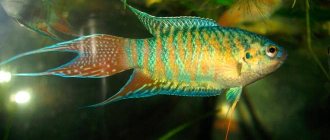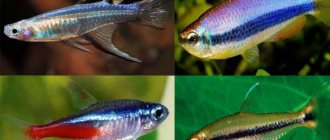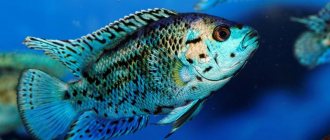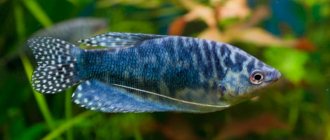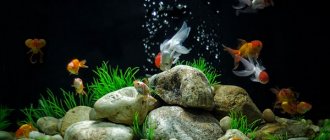Titles and description
A significant part of aquarists, including beginners, keep small herbivorous fish. The reason is less hassle, peaceful coexistence in the aquarium, no problems with food. All this is true. Their opponents are often owners of predatory fish, for whom their pets are a source of special pride.
Predatory fish for the aquarium:
- Astronotus - the most popular cichlid. It has an exceptional intelligence, even a wild individual is attractive, and the decorative ones have very exotic colors - brindle, marbled, veil and albino. Astronotuses are housed in pairs; they are impressive in size and require an aquarium of at least 400 liters. The fish reach 35 cm in length. Such sizes make them more noticeable among many relatives, whom they perceive as a treat. These are quite aggressive fish, ready to attack anything that seems dangerous to them. At the same time, Astronotus remembers the owner and watches him, recognizes him, and accepts food from his hands.
Astronotus - Acantophthalmus is a cute bindweed fish that looks like a worm. In the aquarium, it most often behaves peacefully; it likes to live at the bottom. However, behind the harmless appearance lies a very serious opponent. As soon as someone encroaches on his safety, acanthophthalmus unleashes its thorn. The offender will quickly and for a long time remember that you cannot offend this striped fish. In nature, it is often swallowed by catfish or birds, which further leads to irreversible consequences - the worm breaks through the walls of the stomach, trying to get out. He often succeeds. The larger predator dies.
- Acaras are quarrelsome cichlids from South America, they have a quarrelsome character and can pester their neighbors. These are quite large fish - about 30 cm long, with a shimmering spotted color. The originality of the image is given by the large head, plump lips and large mouth, in which quite large food can easily get lost. Males have a massive fatty growth on their forehead. Territorial integrity is important to Akars. Possessing the tough character of the owner, they practically do not get along with their neighbors. At the same time, if you don’t bother them, they won’t be the first to get into a fight. These fish should not be housed next to small and slow neighbors.
- Belonesox is a predatory viviparous fish. She is so predatory that the female can eat her lover during the mating season. Belonesox is not interested in large fish. He himself grows more than 20 cm. The predator is fed with small fish, fry, tadpoles are allowed. It is important to feed the female well, otherwise dead offspring may be born.
- Snakehead red - a born predator. The body of this fish has an elongated cylindrical shape, a serpentine head, and large eyes. The image is crowned with long dorsal and ventral fins. If the aquarium is large and fed well, it can grow up to 70 cm. The fish has an excellent appetite. In the natural environment of reservoirs in Southeast Asia, it can devour all the fish in the area, then crawls to another body of water (it easily tolerates waterless space for three hours), where it also devours all living things. At home, it is recommended to place this glutton in an aquarium of about 200 liters. It can live alone, or can coexist with large cichlids. For lunch, the red snake catcher prefers small live fish, frogs, earthworms, shrimp meat, fish fillets, pieces of beef or liver. Hand feeding is not recommended; it can confuse the treat with the owner's fingers.
Snakehead red - The red parrot gets its name from its appearance: a beak-shaped head and a bright appearance - from pale yellow to orange-red. The color is fixed by selection; to maintain the color it is necessary to include food with carotenoids in the diet. It will not be possible to breed these fish at home; hybrid males are sterile; if a pair is formed with other cichlids, then the offspring loses the external characteristics of a red parrot.
- The sacbranch catfish grows up to 30 cm. They feed on small fish. The catfish is poisonous and can pose a danger to others when feeding or cleaning the aquarium. It is able to survive on land without water for several hours. He is saved by water from secret bags.
- Piranhas are one of the most aggressive fish living in fresh water. Predatory fish for aquariums differ in character from their natural relatives, capable of eating any living creature to the bone, but the level of aggression is still high. The size of domestic piranhas is about 30 cm. They are kept in a colony of 6 individuals in an aquarium with a volume of at least 500 liters. Feed with raw meat. The regular diet is squid, earthworms, tubifex, shellfish, fish. After the meal, you should immediately remove the remaining treats, this way the water will be preserved better.
- Kalamoicht calabar is a polypterus known as the snake fish. One of the oldest inhabitants of the Earth - its ancestors appeared about 40 million years ago. In an aquarium it grows up to 40 cm in length. The home pond should have soft, loose soil and shelter. Kalamoicht calabar is a lungfish, capable of squeezing into any crack if the aquarium lid is not tightly closed. Capable of outliving even larger neighbors.
- Haplochromis longsnouted are beautiful fish from the cichlid family. Another name is knife cichlids, which they received because of their elongated heads. They grow up to 18-20 cm. Blue scales and red-orange fins make this fish attractive to aquarists. However, behind the artistic appearance lies a cunning predator. When attacking other fish, haplochromis eat their eyeballs. At the same time, they are practically not interested in small fish, as well as individuals with bright and shiny scales. They get along with medium-sized fish: cichlids, angelfish and barbs. You can balance the character of the knife cichlid by having free space in the aquarium - at least 200 liters, shelters and a place for swimming.
- Tetradon is not very popular among aquarists, although it often becomes the star of the aquarium. Gorgeous coloring - large dark spots on a bright green background, bulging eyes, deliberate slowness “hide” the predator. Grows up to 17 cm, lives up to 10 years. Despite the fact that there is no pelvic fin, it is easily controlled by the pectorals, easily maneuvers or hangs in the water column. The muscles and gonads contain a powerful poison that paralyzes an enemy who tries to attack.
Tetradon
Compatibility
The species aquarium is the most harmonious and easy to care for. In this regard, representatives of the cichlid perciformes family are the most popular. They are known for their intelligence, are distinguished by their richness of color, and get along well together.
Carnivorous and herbivorous species are compatible only if they are of similar size and living conditions. In this case, additional consideration should be given to the feeding system. Predatory aquarium fish, as a rule, do not take food from the bottom if it is motionless. And herbivores manage to eat everywhere, often overeating. The exception is feeding aquarium predators with live fish, which they swallow whole.
Temperature and filtration
Most ornamental fish come from the tropics and subtropics. Carnivorous inhabitants of aquariums are predominantly thermophilic and prefer to live at 24–28°C. A significant and prolonged decrease in water temperature leads to diseases. The exception is the diamond perch, for which a comfortable environmental temperature of 15–20°C. The quality of water affects the condition of predatory fish. Comfortable living conditions for pets will be ensured by constant filtration, aeration, and regular water renewal by 30–40%.
Three rules that must be followed:
- The more aggressive and larger the pet, the larger the volume of the aquarium it needs.
- Do not put your hand with damaged skin into the aquarium - this provokes the fish to attack.
- Do not add small fish to the aquarium unless they are food.
Predators in an aquarium do not attack neighbors without reason. The well-known piranhas, when they are full, will not even bite a hand placed in water if there are no open wounds on it.
As a rule, an increase in aggression is associated with spawning, dominance, defense of territory, and protection of offspring. Another reason is hunger. Then it’s worth thinking about the quality of the feed, replacing it or increasing the quantity.
Vivid and memorable species of carnivorous fish
- Astronotus. This cichlid is very popular due to its exceptional intelligence and visual attractiveness. Even the wild form is beautiful, and among the decorative ones there are brindle, harlequin, veil and albino colors. Astronotus are usually kept in pairs due to their size and aggressiveness. A pair of astronotuses requires a tank with a volume of at least 400 liters. Adult individuals reach 35 cm and perceive smaller relatives as hunting objects. While protecting the territory, they attack anything they consider a threat. The required temperature range is from 22 to 28°C, with water acidity 6–8. You can feed both live food (small fish, including) and frozen food, seafood, and fruits. This aquarium fish tends to watch the owner, recognize him, and accept food from his hands.
- Red parrot. It got its name for its beak-shaped head and colorful appearance. These hybrid cichlids are bright orange in color. The color from pale yellow to red-orange is fixed by selection. For color saturation, the diet should include feed containing carotenoids. Breeding is not possible as hybrid males are sterile. And when pairs form with other cichlids, the offspring extremely rarely inherits the external characteristics of a red parrot.
- Piranhas. One of the most aggressive and predatory representatives of freshwater in nature. Produced by Hollywood, the image contrasts sharply with aquarium piranhas, whose level of aggression is significantly lower than natural. They rarely grow more than 30 cm. It is imperative to keep piranhas in a flock of at least 6 individuals in a tank with a volume of 500 liters or more at a temperature of 22 to 26°. Piranhas are fed raw meat. But the basis of the diet is earthworms, squid, tubifex, mollusks, and fish. It is better to clean up leftover food to avoid rapid contamination of the water.
- Kalamoicht calabarensis. A representative of the polypterus, better known as the snake fish, is one of the most ancient inhabitants of the planet. The history of the species goes back about 40 million years. Under artificial conditions it grows up to 40 cm long. Its maintenance requires the presence of soft loose soil and shelters. Kalamoicht is a lungfish, and is able to seep into any crack if the aquarium is not tightly covered. You also need to be careful with settlement, because this predator is capable of destroying even larger neighbors.
Other popular aquarium fish: sacbranch catfish, tetradon, perch, bindweed, shilb.
Breeding
Those who are not afraid of predatory aquarium fish as pets should think about spawning. During the breeding season, the aggression of territorial fish reaches its peak. Therefore, it is recommended that future parents be placed in a separate container approximately two weeks before spawning. The spawning tank is equipped according to the species characteristics. The best food for a pregnant female will be live. The fry feed mainly on brine shrimp, cyclops, and daphnia.
All types of cichlids easily spawn in an aquarium. Being good parents, they treat their offspring with care. In most species, the female picks up the fertilized eggs, incubating them in her mouth. The male can be returned to the aquarium immediately after spawning. After the shell of the eggs bursts, the female will release the babies.
If you are interested in beautiful predators as aquarium pets, do not be deceived by the small size of young individuals and their peaceful behavior. They grow quickly, and upon reaching sexual maturity, aggressiveness will increase sharply. For an aquarium with predatory fish, harmony is possible only by creating optimal conditions for keeping them. Then success is guaranteed!
Interesting videos about predators in the aquarium
AdminAuthor of the article
Did you like the article?
Share with your friends:
Maintenance and care
When it comes to predators in general, danger, aggression, and hunting immediately appear. Predatory aquarium fish stand aside in this regard, since in most cases the term characterizes their food preferences - the presence of meat and fish in their diet.
Predatory aquarium fish look more impressive than their herbivorous relatives, so the aquarium for them should be larger. When choosing a size, consider the following factors:
- Level of aggression of the species;
- Size of fish as an adult;
- Do they live alone, in pairs, in flocks?
For one Apterotonus to feel good, it will need “apartments” of at least 200 liters, and for dwarf Tetradons 10 liters per individual is enough, but they live in flocks.
Important! For most predators, living in a home aquarium is unnatural. They do not grow to their natural size, their diet changes, and some become infertile. Most ornamental fish are accustomed to the climate of the tropics and subtropics, so they prefer to live in water heated to 24–28°C. Due to the drop in temperature, they get sick; with sudden changes, some species may die.
It is better to place the aquarium in a quiet and well-lit place. When decorating an aquarium, it is worth decorating the water landscape with decorative elements - driftwood, stones, clay pots, creating caves, and planting broad-leaved plants.
To create the underwater microclimate the predator needs, you should take care of purchasing the necessary equipment. Since the predators themselves are large, the aquariums are large, it is necessary to install a powerful filter (external), an aerator, and lighting fixtures.
Three rules for owners of predatory aquarium fish:
- The larger and more aggressive the fish, the larger the volume of the aquarium.
- You should not put your hand in the water if your skin is injured - the fish may attack.
- Neighborhood with small fish is undesirable, except when they are feeding.
Features of keeping predatory phenotypes
Many aquarists prefer to keep small herbivorous fish in their home pond, believing that they have less to worry about. This statement is true, but some aquarists are obsessed with keeping carnivorous species of which they are proud and boastful.
Keeping aggressive and predatory representatives is a complex matter and requires adherence to certain rules and nuances. Predators in an aquarium require increased attention and care from the owner, but with proper care, even a carnivorous fish will happily greet an aquarist approaching the tank.
General recommendations:
- The aquarium is located in a well-lit, quiet place. Be sure to install a filter and aerator.
- The size of the reservoir is calculated based on the number and size of fish.
- Aquarium water is used that is saturated with oxygen.
- Driftwood, stones, caves and seaweed are chosen as decorations.
- Vegetation is planted alive, with large leaves and strong roots.
It is also worth mentioning three rules for the owner whose pond contains predatory aquarium fish:
- The larger and more violent the phenotype, the more space is needed.
- It is forbidden to immerse a hand with injuries or wounds inside a tank with predators - this will provoke pets into defense.
- Small fish should not be introduced to carnivorous phenotypes unless they are used as food.
Compatibility with other fish
Despite the fact that at home the diet changes, food does not need to be obtained, aquarium fish predators retain their aggressive nature. If such a hunter is kept hungry, he will gladly feast on his neighbor. Therefore, in most cases, experts recommend making the aquarium a species-specific one.
Beautiful and dangerous
From this point of view, representatives of the cichlid family are the most popular. Smart aquarium fish and predators with a rich palette of colors get along well with each other. African cichlids do not live with South American cichlids, as they require different ambient water temperatures. Dwarf cichlids coexist well with apistograms, platies, mollies, angelfish, and pelmitochromis.
Loners who fight with their own kind - barbs, polypterus, sharks, piranhas and other species. A prosperous neighborhood is possible if there is a spacious “bank”.
You should not experiment and place small fish that prefer algae together with predatory ones, since the inhabitants of a home pond should be approximately the same size for their own peace.
Reasons for aquarium fish attacking neighbors:
- Hunger
- Fight for your territory
- Breeding season;
- Conflict between males for a female;
- Alpha male dominance;
- Similar color of scales or brighter color of the “enemy”;
- Smaller or slower fish;
- Aggressive behavior.
Most popular types
Predatory fish for aquariums are larger in size and brighter in color. They are capable of showing aggression even towards their relatives. All these fish belong to different families.
Representatives of the cichlid family
This family is distinguished by its aggressive character and pronounced territoriality. Among cichlids, intraspecific aggression is often observed, even on the part of males towards females.
The following species are suitable for breeding in aquariums:
- astronotuses;
- Haplochromis long-snouted;
- apistograms;
- discus;
- crenicichlus cordis punctata;
- melanochromis.
There are 6 types of these fish.
Astronotus is the most popular fish among all aquarium predators. Its homeland is the Amazon, Rio Negro and Paraguay basins. The size of an individual can reach 35 cm. It has a very aggressive character, so it is better to keep astronotus as a pair in a separate aquarium. Small “neighbors” can become food for them, and fights will constantly occur with large ones. These cichlids need an aquarium with a volume of 500 to 600 liters. It is very important to provide powerful water filtration.
The long-snouted haplochromis or “knife cichlid” is distinguished by its elongated head shape, reminiscent of a knife blade. In the wild it is a ferocious predator. When attacking other fish, it tends to eat out their eyeballs. In the aquarium it often attacks shiny objects.
The body size of the “knife cichlid” is about 20 cm, the scales are colored blue, and the fins are orange-red. It is possible to move into the same aquarium with barbs or angelfish. To reduce the degree of aggressiveness of Haplochromis, you can place it in an aquarium of at least 200 liters in size, where there are many secluded places.
This fish is very active
Crenicichla is a predator from Brazil that naturally feeds on small fish. In an aquarium, it is quite possible to feed it with earthworms or lean beef. This aquatic inhabitant is extremely unfriendly with its neighbors. One pair will require an aquarium with a volume of at least 400 liters. Crenicichla is very mobile, so do not clutter the aquarium too much so that the fish does not get hurt.
Red-bellied piranhas
These fish are schooling fish; they are kept in an aquarium in groups of 5-8 individuals. They are incompatible with other types of piranha. Being in the same aquarium, healthy strong fish can eat weak or sick relatives.
Distinctive appearance features:
- powerful jaws capable of biting through a finger-thick stick;
- sharp plate teeth;
- powerful tail;
- silver body color with a red belly.
This fish has sharp teeth
You can feed piranha with poultry and live fry of other breeds. With sufficient feeding, these predatory aquarium fish behave calmly, but if there is a lack of food, they can attack their own kind.
Catfish predators
In their homeland, these species are particularly ferocious. Sacbranch catfish live in Asian waters, where they can destroy all the fish that live nearby. After this, they move crawling to new bodies of water for prey. In aquariums, sacbranch catfish behave somewhat calmer.
The body length of the fish reaches 30 cm. The body color is dark gray or black. For such a catfish you need an aquarium with a volume of about 150 liters. You need to feed your “pet” small fish.
Aquarium owners should remember that the sacbranch catfish is poisonous. Its bite can cause a severe allergic reaction.
There are a number of conditions for keeping this fish
The striped shilb is another predator from the catfish family that lives and hunts in schools. One of the inhabitants will need about 60 liters of water. The flock must contain at least 6 individuals. Schilb happily eats live food, but does not refuse frozen meat. If other inhabitants of the aquarium are of similar sizes, the fish will not pay attention to them.
Important conditions for keeping this species are:
- high-quality water aeration;
- good filter;
- sandy soil.
It is very good if there are snags in the center of the aquarium, around which the flock can play.
In this video you will learn more about the five predatory fish in the aquarium:
https://youtube.com/watch?v=w96DuTdmnYA
Pineapple or creeper
Among all the inhabitants of the underwater world, the creeper fish is considered a real “glutton”. In the aquarium, he will not refuse small fish or boiled rice. The fish is unpretentious to the conditions of detention:
- the optimal volume of the aquarium is about 150 liters;
- It is better to settle the climbing perch in small groups of 4-5 individuals;
- the aquarium must be kept closed, as the slider can easily get out;
- It is best to feed the fish raw beef heart.
Apteronotus white-bordered
Another name for the fish is Black Knife. It has a beautiful exotic appearance. These predators are kept one per aquarium, as they do not tolerate anyone on their territory. The volume of the aquarium is 200 liters.
It is enough to feed this fish with live food.
The body size of the Black Knife reaches 35 cm. You can feed it any live food, including shrimp and squid meat.
Belonesox or garfish
This predatory inhabitant of aquariums belongs to the viviparous category. During the mating season, the female is able to eat her partner.
The body length reaches 20 cm. Belonesox is completely indifferent to larger species of fish.
This fish needs to be fed with fry, small fish or tadpoles. It is very important to feed a pregnant female, as otherwise she may give birth to dead offspring.
Diamond Perch
These aquarium fish are predators, although they are small in size, about 6 cm. Such an inhabitant is unlikely to harm larger fish. However, diamond perch also needs meat food. It is best to feed it freshwater fish or beef.
At a certain period, the color of this fish is even more saturated
The perch owes its beautiful name to the shiny inclusions on its fins and body. During spawning, the color of the fish becomes especially attractive.
Snake fish (Kalamoicht kalabarensis)
This inhabitant of the aquatic world combines shyness with predatory habits. It is active mainly at night, so it is better to feed the snake fish in the evening and at night. In aquariums, the body size of such a fish does not exceed 40 cm, while in natural conditions it can grow up to 1 meter in length.
Despite its timidity, the kalamoicht is capable of destroying any “neighbor”, even if it is larger than the snake, so such fish should be kept in a species aquarium with a large number of ground burrows and caves.
Dwarf tetraodon
The size of this aquatic inhabitant does not exceed 25 mm. Due to its modest size, the fish cannot harm swordtails or other fish. The object of her hunt may be aquarium snails. At the same time, tetraodon not only feeds on the meat of mollusks, but also sharpens its sharp teeth on the shells. For one individual, 10 liters of volume is enough. Can be kept in flocks.
The fish has a very beautiful bright color. Its defensive reaction is noteworthy: when a threat arises, the tetraodon doubles in size due to the water it absorbs into its abdomen
These fish can be bred in schools
Feeding
When feeding aquarium predators, several factors must be taken into account. If we are talking about organizing a hunt, then we periodically release “feed” live fish purchased at a pet store. On normal days, predators may well be content with raw meat or fish fillets, shrimp, large worms, tubifex and other protein foods.
The frequency of feeding depends on the type of fish. Some swallow their prey whole, so they are fed 2-3 times a week. In other cases, and these are the majority, predators are fed 2 times a day.
Piranha
Important! Do not overfeed fish; leftover food quickly decomposes, which can lead to poisoning of the aquatic environment and the proliferation of parasites.
However, regular feeding will not 100% prevent you from hunting your neighbors.
Reproduction
Many owners of predatory fish are thinking about breeding them. Cichlids spawn well in aquarium conditions. During the spawning period, bad character reaches its apogee. Therefore, a pair of future parents are moved to another container approximately 2 weeks before the start of spawning.
Basic principles of organizing spawning:
- The spawning ground is set up in a separate container.
- The female is fed live fish.
- The babies are fed artemia, cyclops, and daphnia.
- After spawning, the male is returned to the general aquarium.
In most cases, the female collects the fertilized eggs, creating an incubator in her mouth. As soon as the shell of the eggs bursts, they will emerge into the water. Young individuals are beautiful, but no less aggressive, and their character changes as they mature.
Aggression of aquarium fish
Author: admin07/11/2011, 19-21 I do not adhere to the theoretical calculations of anthropomorphists, however, from the height of my aquarium experience, I can say that each individual, not to mention individual species, has a unique character. Like people, some fish are surprisingly calm and peaceful, while others, on the contrary, get into fights, drive away uninvited guests and attack weak neighbors. Obviously, understanding behavioral reactions will allow you to better navigate the compatibility of fish. It is interesting that many are seduced by aggressive, cruel and cocky fish. The idyll of the water world gives way to regular skirmishes: dizzying races, splashes, muddy water. And when they come to the store, such aquarists are first interested in the most severe species, and then, no matter how comical it may seem, they ask how they will get along with other, by the way no less aggressive, fish. Well, what do you think? It’s clear that from minor fights to serious massacres it’s just a stone’s throw away. However, the majority still prefer to contemplate the tranquility of the water, but even in a well-thought-out community, conflicts sometimes arise. The strong always dominate the weak, this happens both in natural ecosystems and in civilized society. Individuals of one species often consider fish of other species as a delicacy. And even in relatively peaceful communities there are often notorious hooligans. So, what do fish usually fight for? Actually, like people, for food, territory, women and friends. And fish, by the way, look more attractive in this light, because their clashes are not based on political preferences and religious judgments, a kind of healthy selfishness. Of course, the struggle for territory dominates. Some species prefer to swim wherever the current takes them. Others are making serious bids to build an impromptu house where they can relax, raise offspring and feel safe. Such a place could be a snag, a space behind a stone, an area of thickets, or just a dark corner. One way or another, owners are usually not very happy with uninvited guests, mostly, of course, representatives of the same species. This is understandable: competition, as a result of which you can lose your home and offspring. Often in such fights, fish cause very serious damage to each other. The division into “friends and foes” occurs on the basis of body shape, color and shape of individual areas of pigmentation. Sometimes, of course, fish make mistakes, for example, cockerels of the Betta splendens family often attack red fish that have no claims to their territory and females. And this happens only because information about some distinctive features, in particular, red fins, is recorded at the genetic level. There are some signs of aggressiveness that suggest that the fish will conflict with other inhabitants of the aquarium. And forget about the theory of amateurs who believe that there is no need to “bother” with assessing aggressiveness, because it will be enough to simply remove the bully from the aquarium as soon as he gets into a fight. It is somewhat naive to believe that you will notice the fight itself. With this approach, you will most likely judge the aggressiveness of the fish after the fact, assessing the damage caused. Don’t think that fish are so cunning that they prefer to solve their problems without witnesses, it’s just that you don’t look at the aquarium all 24 hours. In addition, in the presence of humans, fish focus on feeding, leaving less pressing everyday issues for the “afternoon” time. It is clear that fights do not go away without a trace: scratches and abrasions on the body, damaged fins, a torn mouth, gouged out eyes clearly indicate, if not the aggressiveness of the fish themselves, then the savage treatment during catching and transportation. One way or another, it’s worth thinking about purchasing other fish. Note that in fish communities there is a certain subordination, therefore fights are often associated with the need to occupy their niche, position in the underwater community. However, regardless of whether the situation has stabilized after some time or not, there is no point in grabbing the net and scattering the fish. The notorious treatment of symptoms will only help at first, then, if the cause of the discord is not eliminated, it will no longer be a means of intimidation, but an improvised stretcher. First, you should try to change the interior of the aquarium, add driftwood and stones that will serve as shelters, or, conversely, clean the area. You can simply change their relative position, placing the shelters in different parts of the aquarium. It is likely that changes in habitat conditions will deprive the bully of his advantage or allow him to resolve territorial claims. When introducing new fish, it is necessary to carry out some kind of cosmetic renovation so that the new inhabitants are not left without personal space. By grouping plants and accessories, you create reliable shelters. And the more reliable and thorough they are, the less reason the fish will have for hostility. If moving accessories does not bring the desired results, you should think about moving out. First you need to decide which fish to “deport”. It all depends on the injuries inflicted by the dominant individual. A defeated and weakened fish becomes a target for all other inhabitants of the aquarium, who can “quietly” attack its territory. In addition, wounds can lead to infection, which can easily result in an epidemic. If the damage inflicted during the battle is insignificant, it is not worth evicting the victim, because in this way you, as it were, encourage the bully. The dominant position of the winner will only strengthen and it is far from a fact that the bully will calm down and not choose a new victim. It is better to place an aggressive individual in a “fish prison”. For small and medium-sized fish, in specialized stores you can find a pen net that hangs in the corner. The bully should be placed inside for a week, while he will feel the presence of other fish and eat normally, but will not be able to get into a fight. In addition, while the dominant individual is absent, the hierarchy will change, and the bully will lose his former authority. The pen can also be used for injured fish as a kind of infirmary. The net pen is also good because during quarantine the fish will seem to be inside the community, because nothing will prevent the spread of their smell. Therefore, after the end of house arrest, the inhabitants of the aquarium will not accept her as a newcomer, as happens when she is temporarily moved to another container. It is also advisable to use a soft mesh so that the fish do not get hurt trying to get out. Note that the above approaches should not be taken as a panacea. For example, if there is significant damage, the fish must be moved to a separate container. For these purposes, a “jar” of 20-40 liters is suitable, which can be covered so that the fish does not jump out. It is worth adding stones and other accessories so that the fish can find a hiding place where it can feel safe. It is not at all necessary to arrange additional lighting, but you will need a small filter and, possibly, a heater: it all depends on the requirements of the particular type of fish. If an additional container is used as a place for safe selection, you should give preference to sponge filters, which certainly will not suck in eggs. In clean water and with good nutrition, the fish will heal on its own. Primary protection against infection is provided by the mucus produced by the fish, the restoration of which is facilitated by various colloids and salt, 1.5 teaspoons for every 5 liters of water. That. For minor injuries, there is no need to give the fish any medications, but you can smear the wounds with iodine. In case of significant injuries, antibiotics will be required: · Sulfur-containing drugs; Drugs from the furanide group, such as nifurpirinol or furazone; · Kanamycin. By the way, the manifestation of aggressiveness among species that do not require territory is a non-trivial task. For example, Tiger barbs, like schoolchildren, love to chase each other for fun, and, living in an insufficiently large group (usually less than 6 individuals), they often switch to other inhabitants of the aquarium. As a result, the solution to the problem lies not in removing the bullies, but in introducing more fish of this species into the aquarium. Finally, we note that many territorial species require more and more space as they grow. And if this factor was not taken into account when calculating the permissible population of the aquarium, it is likely that some fish will need to be resettled. Author: AquaDreamsArt specially for nemo.by
0

